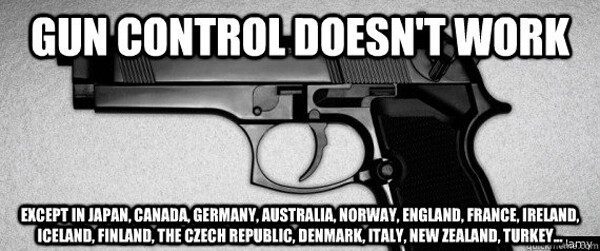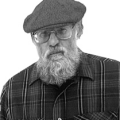Banning Assault Rifles WORKS!

Horrific mass shootings do not have to happen. They are not inevitable. We know how to reduce the number of mass shootings and the number of people killed in these attacks. We know this because it has been successfully done in other countries.
Australia is a good example because of their success and their similarity to our country. Like us Australians have a wild west, rugged individual mentality, and a tradition of gun ownership. Guns and hunting are popular. They have similar macho attitudes about manliness. They drink a lot of beer. The Aussies love rugby which, like American football, is a very violent game. They have problems with crime, spousal abuse, unemployment, and mental illness. They also have a similar history of racism, discrimination for minorities, and the killing of Aborigines. But they have not had a mass shooting since 1996.
In 1996 Australia experienced a mass shooting that radically changed their attitudes toward gun “rights” and resulted in serious gun control legislation. In the Port Arthur Massacre a 28 year old white male killed 35 and wounded 23 people at a tourist attraction using an assault rifle. It was the deadliest mass shooting in Australian history. Australians reacted to the event with shock and a huge public demand for action.
The Australian government moved quickly to restrict the availability of firearms, especially assault style weapons. The Prime Minister John Howard led the effort to pass the National Firearms Programme Implementation Act of 1996. This law restricted the private ownership of high capacity semi-automatic rifles, semi-automatic shotguns, pump-action shotguns and required uniform firearms licensing. It established a national firearms registry and a 28-day waiting period for gun purchases. It created a “buy back” program that purchased and destroyed 643,000 civilian-owned firearms.
There was opposition to gun control from right wing groups similar to those in this country (they have an Aussie version of the NRA). Arguments against gun control ranged from “guns don’t kill people” to calling the legislation an insult to the vast majority of law-abiding gun owners. But 85% of Australians supported action and the legislation passed with wide BIPARTISAN support.
The number of mass shootings in Australia (incidents with five or more people killed other than the shooter) dropped from 13 in the 18-year period before 1996 to ZERO after the Port Arthur Massacre. The New York Times reports gun-related homicides dropped 59% and suicides were down 65% between 1995 and 2006. FEWER GUNS WITH REASONABLE CONTROLS MEANS FEWER DEATHS!
Scotland also suffered a horrific mass shooting in 1996. In Dunblane, a small rural community, 16 elementary school children and their teacher were gunned down in three minutes by a 43 year old man with four handguns. Again a huge public outcry demanded political action. Prime Minister John Major of the ruling center-right Liberal Party joined with groups from across the political spectrum to pass restrictions on gun ownership. In 1997 the British government banned the private ownership of automatic weapons and handguns.
The U.K. has some of the world’s strictest gun ownership laws. It is rare for civilians to own private firearms. Scotland has a population of 5.3 million, slightly less than Wisconsin. In 2015 there were 55 homicides with only two deaths using guns. Wisconsin had over 200 gun related deaths. Since 2004 Wisconsin has had 6 mass shootings.
Canada, sometimes called the 51st state, is another country very similar in history and culture to us. If tomorrow you were to wake up being a Canadian you would hardly notice a difference (except for the metric system and healthcare). Canadians own many guns, hunt and are just as “free” as Americans. But they have a long history of controlling access and use of firearms. Handgun registration became law in 1934, and automatic firearm registration was added in 1951. Currently firearms are classified into three categories; 1) “prohibited” firearms include military-grade assault weapons and sawed-off rifles or shotguns, 2) handguns and civilian assault rifles are “restricted,” and 3) “non-restricted” hunting rifles and shotguns. You can only hunt with a non-restricted weapon. High-capacity magazines are banned. Handguns are limited to ten rounds and most semi-automatic rifles to five rounds. All gun owners must have a license, pass a background check, and a safety course. There is a minimum 28 day waiting period to get a license and it must be renewed every five years. Purchase of ammunition is regulated.
Canada is not immune to gun deaths or mass shootings. But the numbers in Canada are very small in comparison to the U.S. Canada has had only had 13 mass shootings since 1965. Canada has about 700 gun related deaths per year; we have 33,000. Canada has 30.8 guns per 100 people to our 112.9. FEWER GUNS MEANS FEWER DEATHS BUT STRONGER GUN LAWS, AND SPECIFICALLY RESTRICTIONS ON ASSAULT RIFLES AND HIGH CAPACITY MAGAZINES MAKES A DIFFERENCE.
Australia, Britain, Canada and the United States are all English speaking countries with related history, similar cultures, and democratic governments. One difference is the lack of social support services in the U.S. We do not have universal health care or good mental health services. We have many more children growing up in poverty. We have a much bigger divide between the well off and the poor. Could this lack of social support increase social tensions, anxiety, fear of loosing out, fear of others, and promote more gun violence? I would hypothesize that it does. We don’t know for sure but it seems plausible.
We DO KNOW that the number of guns, the widespread easy access to rapid fire guns, and our lax gun laws result in MANY more deaths and injuries than in these three similar countries. We DO KNOW that the influence of the gun lobby and the spinelessness of our bought-and-paid-for politicians make sensible action difficult. But the Aussies, Brits, and Canucks prove sensible action is possible and that gun control WORKS!
We, the people, just need to get mad enough to make it happen.

